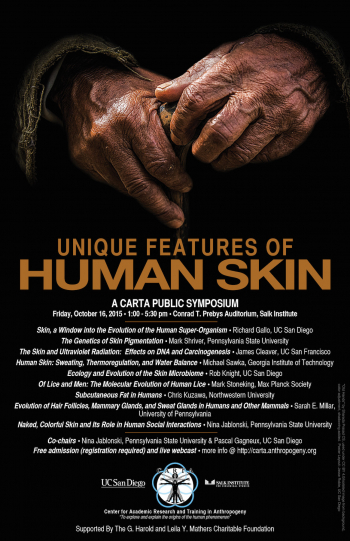Unique Features of Human Skin
Pascal Gagneux, UC San Diego
Nina Jablonski, Pennsylvania State University
Summary
The skin is the major interface between the human body and its environment. It supports diverse and complex functions from protection to vitamin photosynthesis, thermoregulation, and communication. Although the structure and function of human skin have been well characterized, the evolution of human skin remains inadequately understood. Great strides have been realized in the study of the evolution of skin pigmentation, but the evolution of functional nakedness, humans’ prodigious ability to sweat, and the origins of the human breast (the body’s largest modified sweat gland) are still largely matters of conjecture. The skin’s microbiome is emerging as one of most important factors in maintaining barrier functions, but much remains to be discovered about its diversity and roles in health and disease. How can the many gaps in our knowledge of the evolution of human skin be closed? This symposium will bring together scientists representing evolutionary biology, genetics, dermatology, anthropology, and physiology to share their knowledge and questions about human skin in an explicitly evolutionary framework.
Media for each talk can be played by clicking on icons in the table below, or by clicking on the individual talk titles below and then the attachment file at the bottom of the page.
| Speakers | Media | Session |
|---|---|---|
 Ajit Varki |
|
Welcome |
 Nina Jablonski |
|
Opening Remarks |
 Richard Gallo |
|
Skin, a Window Into the Evolution of the Human Super-Organism All life must establish an external barrier that simultaneously interacts with and defends itself from the outside world. Skin is our most important barrier, and human skin has many functions that are in common with other animals but also unique to our species. General skin functions include sensing danger, regulation of internal temperature, maintaining fluid balance and mounting visual sexual displays. Human life also depends on the capacity of our skin to protect us from specific... read more |
 Mark Shriver |
|
The Genetics of Skin Pigmentation How many genes determine human skin color? This question is deceptively simple and direct. Although there are over 100 genes that can lead to clinically-significant pigmentary disorders such as albinism, only four genes are responsible for most of the skin color differences between West African and European populations. The genes that underlie skin color differences between populations are usually also genes that can cause pigmentary disorders. Genes that affect skin color variation in humans... read more |
 James Cleaver |
|
The Skin and Ultraviolet Radiation: Effects on DNA and Carcinogenesis The hereditary syndromes xeroderma pigmentosum (XP) and Cockayne syndrome (CS) have mutations in the nucleotide excision repair (NER) pathway. XP shows an extremely high incidence of solar-induced skin cancer and in some cases neurological disease. CS shows photosensitivity, developmental disorders and neurological disease, but not cancer. XP is associated with mutations in components of the global genome repair (GGR) branch of NER that repairs regions of the genome that do not code for... read more |
 Michael Sawka |
|
Human Skin: Sweating, Thermoregulation, and Water Balance Humans are tropical animals, and given access to shade and adequate water, healthy persons can tolerate extended exposure to any naturally occurring climatic heat stress. This talk examines the role of skin in human thermoregulation as a potentially important evolutionary factor to modern man. Two strong selective factors for survival in early hominins were the ability to forage during peak daily heat when their predators were not a threat, and the capability for persistence hunting (track and... read more |
 Rob Knight |
|
Ecology and Evolution of the Skin Microbiome Like the microbiome at other human body sites, the human skin microbiome is remarkably diverse. Unlike our other microbiomes, the skin microbiome is in intimate contact with our physical environment, leading to a bidirectional transfer of microbes. Here I describe some of the functions of the human skin microbiome, how it and its complex chemical repertoire differ from that of other animals that have been studied including chimpanzees, dogs, amphibians and reptiles, and what we are starting to... read more |
 Mark Stoneking |
|
Of Lice and Men: The Molecular Evolution of Human Lice Lice are ubiquitous parasites, as they infest practically all mammals and even birds. However, while most mammals are parasitized by just one type of lice, humans are blessed with three different kinds of lice, informally known as the head louse, the body louse, and the pubic louse. Moreover, these lice are all obligate parasites of humans, meaning that they cannot live on other animals, and they cannot exist for more than ~24 hours away from the human body without feeding. Thus, these human... read more |
 Chris Kuzawa |
|
Subcutaneous Fat in Humans Humans are unusually fat as a species, and this trait is particularly evident at birth, when our newborns enter the world with a large layer of “baby fat.” One proposal to explain our large fat stores is that they evolved as a “brain battery,” or backup energy supply to buffer our costly brains, which are vulnerable to energy shortfall. Although humans are especially fat at birth, we lose much of our abundant fat stores after weaning, and human adiposity reaches its lowest level during... read more |
 Sarah Millar |
|
Evolution of Hair Follicles, Mammary Glands, and Sweat Glands in Humans and Other Mammals Skin appendages such as hair follicles, mammary glands and sweat glands develop during embryonic life through a series of interactions between surface epithelial cells and underlying mesenchymal cells. In each case, these events are regulated by similar sets of conserved cell-cell signaling pathways. These observations suggest that diverse appendages may have evolved from a common precursor. Most evidence from evolutionary studies suggests that this precursor was a simple glandular structure... read more |
 Nina Jablonski |
|
Naked, Colorful Skin and Its Role in Human Social Interactions The evolution of mostly naked skin in the human lineage heralded major changes in the biological and social functions of skin. The evolution of enhanced barrier functions of the epidermis made it possible for functionally naked skin to repel water, resist abrasion, and combat harmful microbes and ectoparasites. Naked skin also changed the nature of human social interactions, both at a distance and at close quarters, although many of the details of exactly what happened when are not yet known.... read more |
 All Speakers |
|
Wrap Up, Question and Answer, and Closing Remarks |
| Attachment | Size |
|---|---|
| 214.03 KB | |
| 277.25 KB | |
| 148.5 KB | |
| 3.39 MB | |
| 800.91 KB |
If you enjoy this event, please consider supporting CARTA's quest to explore and explain the human phenomenon.


